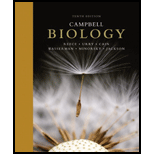
What cell-surface event would likely fail if a sperm contacted an egg of another species?
To identify: The cell-surface event that has failed in case a sperm contacts an egg of different species.
Introduction:
The process of binding of a sperm to a receptor on the egg surface is species specific. There are many events that lead to the fusion of plasma membranes of egg and sperm.
- 1. The sperm contacts the jelly coat of egg.
- 2. The release of enzymes from the acrosomes.
- 3. Fusion of the sperm and egg plasma membrane.
- 4. Release of cortical granules and formation of fertilization envelope.
- 5. Entry of the sperm nucleus.
Explanation of Solution
There are some cell specific surface proteins that is essential for the fusion of sperm and egg. These protein are necessary for the proper recognition. If the gametes are from different species it is not possible for the sperm to induce the acrosome reaction. It is not possible for the sperm to burn its way through the egg’s outer layer.
All the reactions of the fertilization is possible only if the sperm and egg are from the same species. It would not occur if the sperm and egg are from different species.
Want to see more full solutions like this?
Chapter 47 Solutions
Campbell Biology (10th Edition)
- Noggin mutation: The mouse, one of the phenotypic consequences of Noggin mutationis mispatterning of the spinal cord, in the posterior region of the mouse embryo, suchthat in the hindlimb region the more ventral fates are lost, and the dorsal Pax3 domain isexpanded. (this experiment is not in the lectures).a. Hypothesis for why: What would be your hypothesis for why the ventral fatesare lost and dorsal fates expanded? Include in your answer the words notochord,BMP, SHH and either (or both of) surface ectoderm or lateral plate mesodermarrow_forwardNot part of a graded assignment, from a past midtermarrow_forwardNot part of a graded assignment, from a past midtermarrow_forward
- please helparrow_forwardWhat does the heavy dark line along collecting duct tell us about water reabsorption in this individual at this time? What does the heavy dark line along collecting duct tell us about ADH secretion in this individual at this time?arrow_forwardBiology grade 10 study guidearrow_forward
 Human Biology (MindTap Course List)BiologyISBN:9781305112100Author:Cecie Starr, Beverly McMillanPublisher:Cengage Learning
Human Biology (MindTap Course List)BiologyISBN:9781305112100Author:Cecie Starr, Beverly McMillanPublisher:Cengage Learning Human Heredity: Principles and Issues (MindTap Co...BiologyISBN:9781305251052Author:Michael CummingsPublisher:Cengage Learning
Human Heredity: Principles and Issues (MindTap Co...BiologyISBN:9781305251052Author:Michael CummingsPublisher:Cengage Learning Biology (MindTap Course List)BiologyISBN:9781337392938Author:Eldra Solomon, Charles Martin, Diana W. Martin, Linda R. BergPublisher:Cengage Learning
Biology (MindTap Course List)BiologyISBN:9781337392938Author:Eldra Solomon, Charles Martin, Diana W. Martin, Linda R. BergPublisher:Cengage Learning
 Concepts of BiologyBiologyISBN:9781938168116Author:Samantha Fowler, Rebecca Roush, James WisePublisher:OpenStax College
Concepts of BiologyBiologyISBN:9781938168116Author:Samantha Fowler, Rebecca Roush, James WisePublisher:OpenStax College Biology 2eBiologyISBN:9781947172517Author:Matthew Douglas, Jung Choi, Mary Ann ClarkPublisher:OpenStax
Biology 2eBiologyISBN:9781947172517Author:Matthew Douglas, Jung Choi, Mary Ann ClarkPublisher:OpenStax





